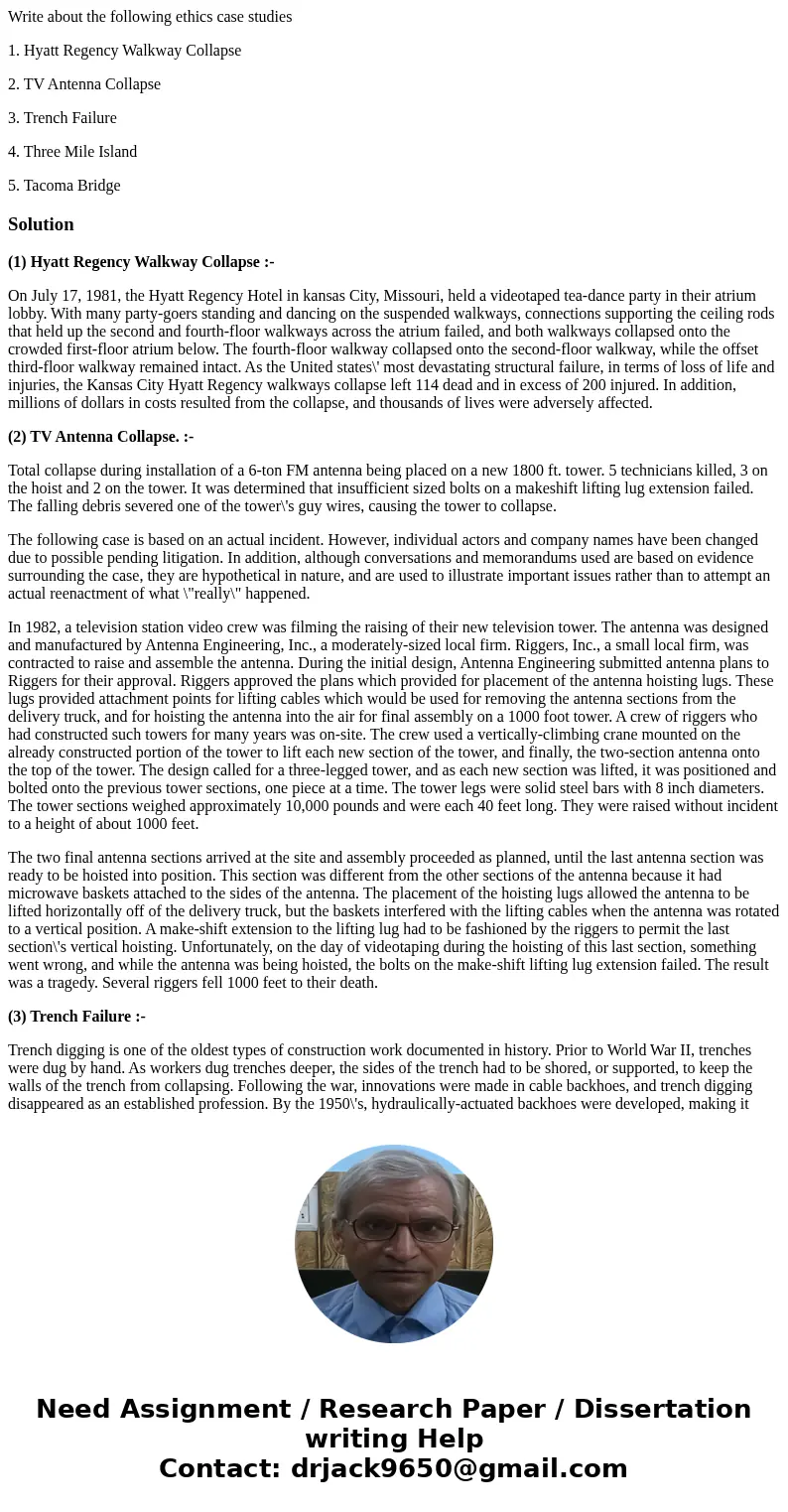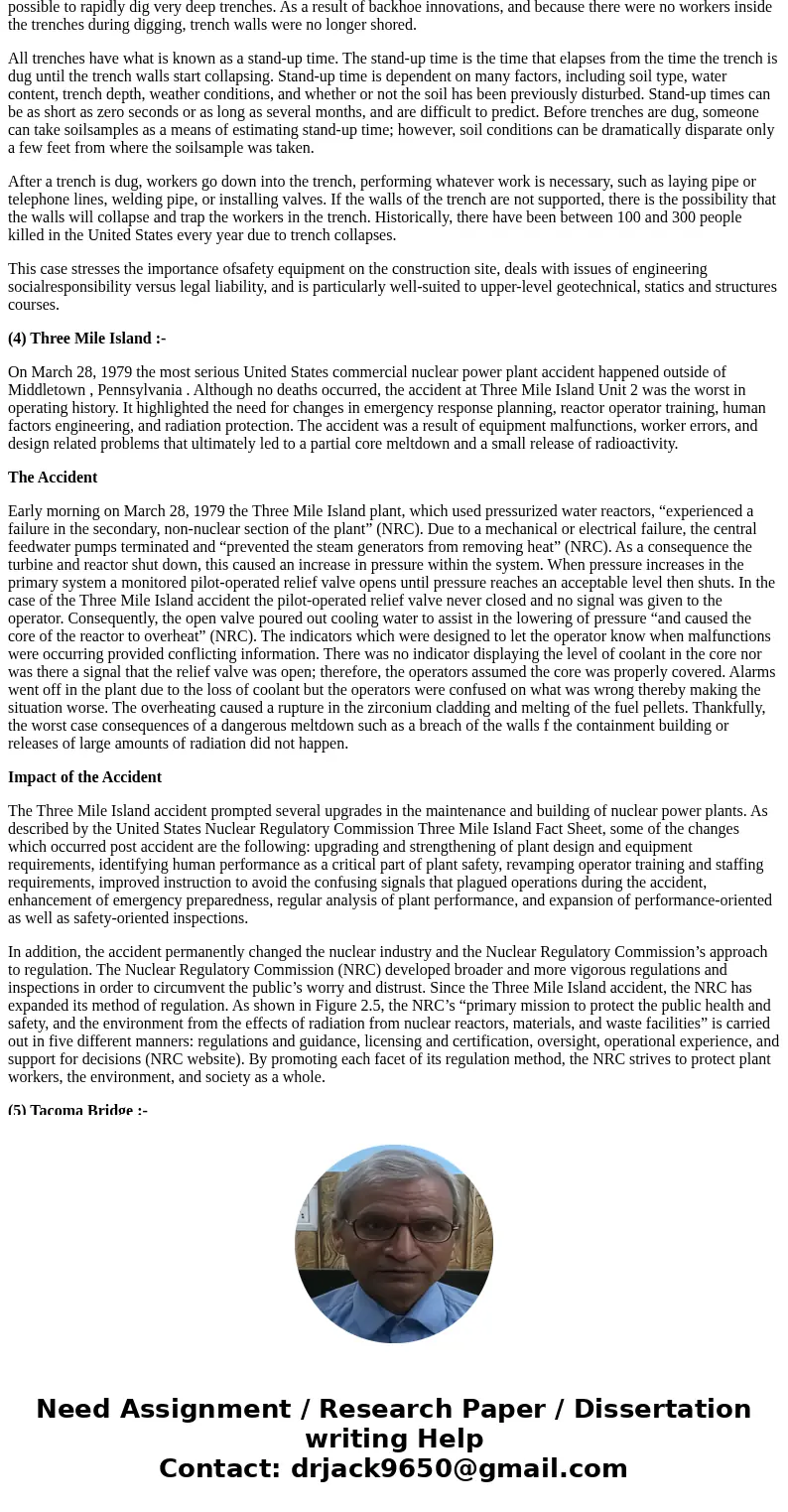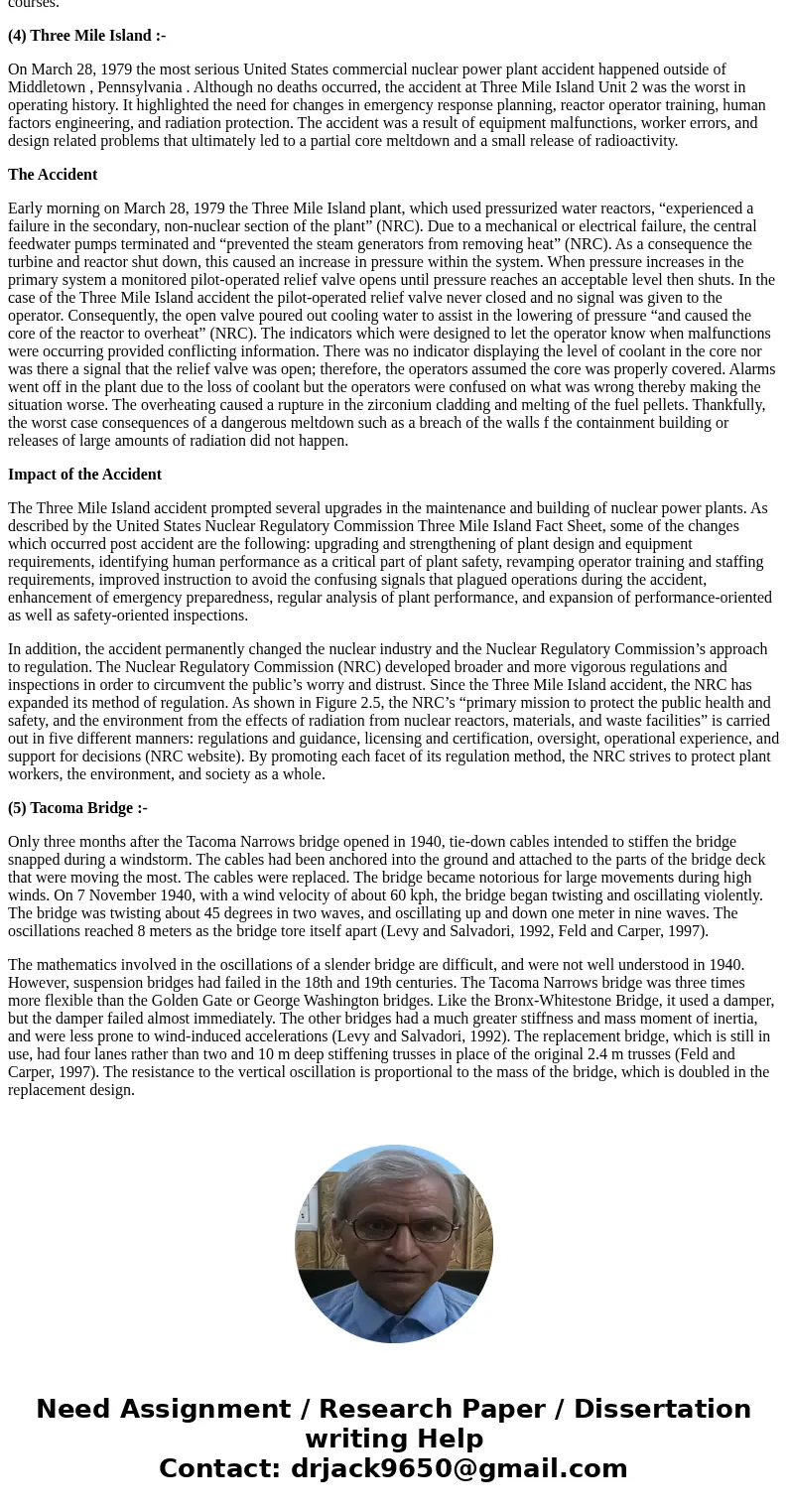Write about the following ethics case studies 1 Hyatt Regenc
Write about the following ethics case studies
1. Hyatt Regency Walkway Collapse
2. TV Antenna Collapse
3. Trench Failure
4. Three Mile Island
5. Tacoma Bridge
Solution
(1) Hyatt Regency Walkway Collapse :-
On July 17, 1981, the Hyatt Regency Hotel in kansas City, Missouri, held a videotaped tea-dance party in their atrium lobby. With many party-goers standing and dancing on the suspended walkways, connections supporting the ceiling rods that held up the second and fourth-floor walkways across the atrium failed, and both walkways collapsed onto the crowded first-floor atrium below. The fourth-floor walkway collapsed onto the second-floor walkway, while the offset third-floor walkway remained intact. As the United states\' most devastating structural failure, in terms of loss of life and injuries, the Kansas City Hyatt Regency walkways collapse left 114 dead and in excess of 200 injured. In addition, millions of dollars in costs resulted from the collapse, and thousands of lives were adversely affected.
(2) TV Antenna Collapse. :-
Total collapse during installation of a 6-ton FM antenna being placed on a new 1800 ft. tower. 5 technicians killed, 3 on the hoist and 2 on the tower. It was determined that insufficient sized bolts on a makeshift lifting lug extension failed. The falling debris severed one of the tower\'s guy wires, causing the tower to collapse.
The following case is based on an actual incident. However, individual actors and company names have been changed due to possible pending litigation. In addition, although conversations and memorandums used are based on evidence surrounding the case, they are hypothetical in nature, and are used to illustrate important issues rather than to attempt an actual reenactment of what \"really\" happened.
In 1982, a television station video crew was filming the raising of their new television tower. The antenna was designed and manufactured by Antenna Engineering, Inc., a moderately-sized local firm. Riggers, Inc., a small local firm, was contracted to raise and assemble the antenna. During the initial design, Antenna Engineering submitted antenna plans to Riggers for their approval. Riggers approved the plans which provided for placement of the antenna hoisting lugs. These lugs provided attachment points for lifting cables which would be used for removing the antenna sections from the delivery truck, and for hoisting the antenna into the air for final assembly on a 1000 foot tower. A crew of riggers who had constructed such towers for many years was on-site. The crew used a vertically-climbing crane mounted on the already constructed portion of the tower to lift each new section of the tower, and finally, the two-section antenna onto the top of the tower. The design called for a three-legged tower, and as each new section was lifted, it was positioned and bolted onto the previous tower sections, one piece at a time. The tower legs were solid steel bars with 8 inch diameters. The tower sections weighed approximately 10,000 pounds and were each 40 feet long. They were raised without incident to a height of about 1000 feet.
The two final antenna sections arrived at the site and assembly proceeded as planned, until the last antenna section was ready to be hoisted into position. This section was different from the other sections of the antenna because it had microwave baskets attached to the sides of the antenna. The placement of the hoisting lugs allowed the antenna to be lifted horizontally off of the delivery truck, but the baskets interfered with the lifting cables when the antenna was rotated to a vertical position. A make-shift extension to the lifting lug had to be fashioned by the riggers to permit the last section\'s vertical hoisting. Unfortunately, on the day of videotaping during the hoisting of this last section, something went wrong, and while the antenna was being hoisted, the bolts on the make-shift lifting lug extension failed. The result was a tragedy. Several riggers fell 1000 feet to their death.
(3) Trench Failure :-
Trench digging is one of the oldest types of construction work documented in history. Prior to World War II, trenches were dug by hand. As workers dug trenches deeper, the sides of the trench had to be shored, or supported, to keep the walls of the trench from collapsing. Following the war, innovations were made in cable backhoes, and trench digging disappeared as an established profession. By the 1950\'s, hydraulically-actuated backhoes were developed, making it possible to rapidly dig very deep trenches. As a result of backhoe innovations, and because there were no workers inside the trenches during digging, trench walls were no longer shored.
All trenches have what is known as a stand-up time. The stand-up time is the time that elapses from the time the trench is dug until the trench walls start collapsing. Stand-up time is dependent on many factors, including soil type, water content, trench depth, weather conditions, and whether or not the soil has been previously disturbed. Stand-up times can be as short as zero seconds or as long as several months, and are difficult to predict. Before trenches are dug, someone can take soilsamples as a means of estimating stand-up time; however, soil conditions can be dramatically disparate only a few feet from where the soilsample was taken.
After a trench is dug, workers go down into the trench, performing whatever work is necessary, such as laying pipe or telephone lines, welding pipe, or installing valves. If the walls of the trench are not supported, there is the possibility that the walls will collapse and trap the workers in the trench. Historically, there have been between 100 and 300 people killed in the United States every year due to trench collapses.
This case stresses the importance ofsafety equipment on the construction site, deals with issues of engineering socialresponsibility versus legal liability, and is particularly well-suited to upper-level geotechnical, statics and structures courses.
(4) Three Mile Island :-
On March 28, 1979 the most serious United States commercial nuclear power plant accident happened outside of Middletown , Pennsylvania . Although no deaths occurred, the accident at Three Mile Island Unit 2 was the worst in operating history. It highlighted the need for changes in emergency response planning, reactor operator training, human factors engineering, and radiation protection. The accident was a result of equipment malfunctions, worker errors, and design related problems that ultimately led to a partial core meltdown and a small release of radioactivity.
The Accident
Early morning on March 28, 1979 the Three Mile Island plant, which used pressurized water reactors, “experienced a failure in the secondary, non-nuclear section of the plant” (NRC). Due to a mechanical or electrical failure, the central feedwater pumps terminated and “prevented the steam generators from removing heat” (NRC). As a consequence the turbine and reactor shut down, this caused an increase in pressure within the system. When pressure increases in the primary system a monitored pilot-operated relief valve opens until pressure reaches an acceptable level then shuts. In the case of the Three Mile Island accident the pilot-operated relief valve never closed and no signal was given to the operator. Consequently, the open valve poured out cooling water to assist in the lowering of pressure “and caused the core of the reactor to overheat” (NRC). The indicators which were designed to let the operator know when malfunctions were occurring provided conflicting information. There was no indicator displaying the level of coolant in the core nor was there a signal that the relief valve was open; therefore, the operators assumed the core was properly covered. Alarms went off in the plant due to the loss of coolant but the operators were confused on what was wrong thereby making the situation worse. The overheating caused a rupture in the zirconium cladding and melting of the fuel pellets. Thankfully, the worst case consequences of a dangerous meltdown such as a breach of the walls f the containment building or releases of large amounts of radiation did not happen.
Impact of the Accident
The Three Mile Island accident prompted several upgrades in the maintenance and building of nuclear power plants. As described by the United States Nuclear Regulatory Commission Three Mile Island Fact Sheet, some of the changes which occurred post accident are the following: upgrading and strengthening of plant design and equipment requirements, identifying human performance as a critical part of plant safety, revamping operator training and staffing requirements, improved instruction to avoid the confusing signals that plagued operations during the accident, enhancement of emergency preparedness, regular analysis of plant performance, and expansion of performance-oriented as well as safety-oriented inspections.
In addition, the accident permanently changed the nuclear industry and the Nuclear Regulatory Commission’s approach to regulation. The Nuclear Regulatory Commission (NRC) developed broader and more vigorous regulations and inspections in order to circumvent the public’s worry and distrust. Since the Three Mile Island accident, the NRC has expanded its method of regulation. As shown in Figure 2.5, the NRC’s “primary mission to protect the public health and safety, and the environment from the effects of radiation from nuclear reactors, materials, and waste facilities” is carried out in five different manners: regulations and guidance, licensing and certification, oversight, operational experience, and support for decisions (NRC website). By promoting each facet of its regulation method, the NRC strives to protect plant workers, the environment, and society as a whole.
(5) Tacoma Bridge :-
Only three months after the Tacoma Narrows bridge opened in 1940, tie-down cables intended to stiffen the bridge snapped during a windstorm. The cables had been anchored into the ground and attached to the parts of the bridge deck that were moving the most. The cables were replaced. The bridge became notorious for large movements during high winds. On 7 November 1940, with a wind velocity of about 60 kph, the bridge began twisting and oscillating violently. The bridge was twisting about 45 degrees in two waves, and oscillating up and down one meter in nine waves. The oscillations reached 8 meters as the bridge tore itself apart (Levy and Salvadori, 1992, Feld and Carper, 1997).
The mathematics involved in the oscillations of a slender bridge are difficult, and were not well understood in 1940. However, suspension bridges had failed in the 18th and 19th centuries. The Tacoma Narrows bridge was three times more flexible than the Golden Gate or George Washington bridges. Like the Bronx-Whitestone Bridge, it used a damper, but the damper failed almost immediately. The other bridges had a much greater stiffness and mass moment of inertia, and were less prone to wind-induced accelerations (Levy and Salvadori, 1992). The replacement bridge, which is still in use, had four lanes rather than two and 10 m deep stiffening trusses in place of the original 2.4 m trusses (Feld and Carper, 1997). The resistance to the vertical oscillation is proportional to the mass of the bridge, which is doubled in the replacement design.



 Homework Sourse
Homework Sourse